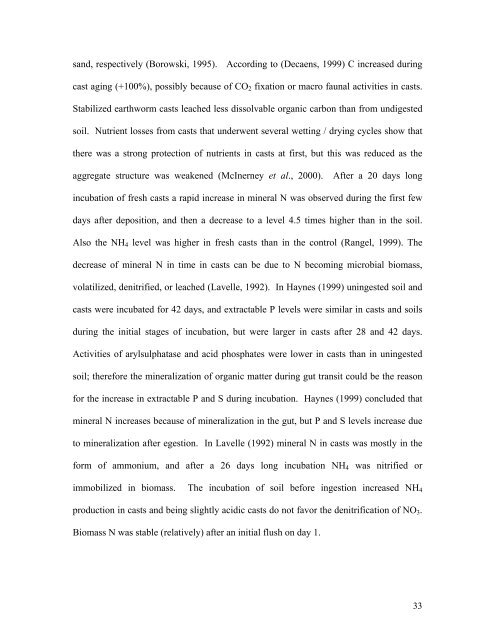Mekelle University The School of Graduate Studies Faculty of ...
Mekelle University The School of Graduate Studies Faculty of ...
Mekelle University The School of Graduate Studies Faculty of ...
- No tags were found...
Create successful ePaper yourself
Turn your PDF publications into a flip-book with our unique Google optimized e-Paper software.
sand, respectively (Borowski, 1995). According to (Decaens, 1999) C increased duringcast aging (+100%), possibly because <strong>of</strong> CO 2 fixation or macro faunal activities in casts.Stabilized earthworm casts leached less dissolvable organic carbon than from undigestedsoil. Nutrient losses from casts that underwent several wetting / drying cycles show thatthere was a strong protection <strong>of</strong> nutrients in casts at first, but this was reduced as theaggregate structure was weakened (McInerney et al., 2000). After a 20 days longincubation <strong>of</strong> fresh casts a rapid increase in mineral N was observed during the first fewdays after deposition, and then a decrease to a level 4.5 times higher than in the soil.Also the NH 4 level was higher in fresh casts than in the control (Rangel, 1999). <strong>The</strong>decrease <strong>of</strong> mineral N in time in casts can be due to N becoming microbial biomass,volatilized, denitrified, or leached (Lavelle, 1992). In Haynes (1999) uningested soil andcasts were incubated for 42 days, and extractable P levels were similar in casts and soilsduring the initial stages <strong>of</strong> incubation, but were larger in casts after 28 and 42 days.Activities <strong>of</strong> arylsulphatase and acid phosphates were lower in casts than in uningestedsoil; therefore the mineralization <strong>of</strong> organic matter during gut transit could be the reasonfor the increase in extractable P and S during incubation. Haynes (1999) concluded thatmineral N increases because <strong>of</strong> mineralization in the gut, but P and S levels increase dueto mineralization after egestion. In Lavelle (1992) mineral N in casts was mostly in theform <strong>of</strong> ammonium, and after a 26 days long incubation NH 4 was nitrified orimmobilized in biomass. <strong>The</strong> incubation <strong>of</strong> soil before ingestion increased NH 4production in casts and being slightly acidic casts do not favor the denitrification <strong>of</strong> NO 3 .Biomass N was stable (relatively) after an initial flush on day 1.33
















